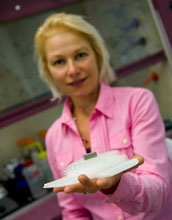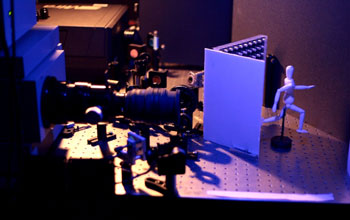

| Visitors Now: | |
| Total Visits: | |
| Total Stories: |

| Story Views | |
| Now: | |
| Last Hour: | |
| Last 24 Hours: | |
| Total: | |
2012 Popular Mechanics Breakthrough Awardees Announced
Popular Mechanics has announced its 2012 Breakthrough Awards. Awardees include three teams whose work received critical support from the National Science Foundation (NSF).
Jessy Grizzle of the University of Michigan and Jonathan Hurst of Oregon State University received a Popular Mechanics Innovator Award for their team’s development of the MABEL bipedal robot. One of the fastest-moving and most sophisticated bipedal robots on Earth, the work on MABEL and her predecessors has been supported by NSF since 1999 through a range of grants including awards to Grizzle and to Hurst. A feature story produced in partnership with LiveScience.com describes MABEL.
Credit: Rose Anderson and Catharine June, University of Michigan
“Unlike other robots, MABEL has human like gait and a reflex response that allows it to step over obstacles” says Radhakisan Baheti, an NSF program officer in the Directorate for Engineering who has funded the work for over a decade. “Innovations in feedback control theory–through the study of highly nonlinear dynamics–have played a key role in MABEL’s bipedal locomotion design.”
Julia R. Greer of Caltech, Lorenzo Valdevit of University of California, Irvine, and their collaborators Alan Jacobson, William Carter, and Toby Schaedler at Malibu, Calif., based HRL Laboratories received a Popular Mechanics Innovator Award for their team’s development of micro-lattice ultralight metal. The material is light enough to sit atop a dandelion’s fluffy seeds without damaging them, yet is also strong, and compressible. Greer is an NSF CAREER awardee with several NSF grants, and Valdevit has also receivedNSF support.
Caltech materials science expert Julia Greer holding the product of her lab’s research: two polymer micro-truss skeletons topped by a smaller, hollow nickel-phosphorous micro-truss. Greer and her collaborators Lorenzo Valdevit of University of California, Irvine, and Alan Jacobson, William Carter, and Toby Schaedler at Malibu, Calif., based HRL Laboratories received a Popular Mechanics Innovator Award for their team’s development of micro-lattice ultralight metal.

Experimental setup of the CORNAR system developed for capturing images of obscured objects using ultra-fast image processing for images created by reflected laser light. The research was conducted by Christopher Barsi, Moungi Bawendi, Otkrist Gupta and Ramesh Raskar of the MIT Media Lab and colleagues Andreas Velten of the Univ. of Wisconsin, Thomas Willwacher of Harvard University, and Ashok Veeraraghavan of Rice University, and the team recently won a Popular Mechanics Breakthrough award for their work.

Credit: Setup by Andreas Velten, photos taken by Christopher Barsi; MIT
Christopher Barsi, Moungi Bawendi, Otkrist Gupta and Ramesh Raskar of the MIT Media Lab and colleagues Andreas Velten of the Univ. of Wisconsin, Thomas Willwacher of Harvard University, and Ashok Veeraraghavan of Rice University received a Popular Mechanics Innovator Award for their team’s development of a laser camera that can see around corners. The technology bounces laser light off surfaces and targets, processing the results to reveal objects otherwise obscured by walls and other obstacles. Raskar is an NSF Innovation Corps (I-Corps) grantee and has received several NSF grants.
“Light transport theory plays a significant role in computer graphics and visualization,” says Lawrence Rosenblum, an NSF program officer in the Directorate for Computer & Information Science & Engineering who supported Raskar’s work. “One of Raskar’s grants involves developing computational methods for ultra-fast imaging, which is necessary for developing this breakthrough. We anticipate that his innovative work will establish a new area of graphics research, and perhaps novel hardware capabilities.”
Popular Mechanics will present all of the awards in a ceremony this evening, and will feature the awards in the November issue of the magazine. The ceremony will also highlight this year’s Leadership Award winner, Elon Musk, the CEO of SpaceX and Tesla Motors.
“We are once again excited to recognize this year’s list of incredible honorees for their role in shaping the future,” says James B. Meigs, editor-in-chief of Popular Mechanics. “From a featherweight metal to the world’s fastest and most electrically efficient supercomputer, this year’s winners embody the creative spirit that the Breakthrough Awards were founded upon.”
A full list of winners, including short features about their work, can be found at the Popular Mechanicswebsite. You can also follow the 2012 Breakthrough Awards on Twitter @PopMech, #BTA2012.



